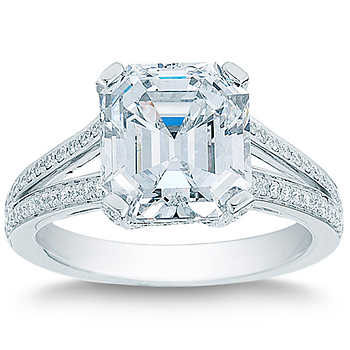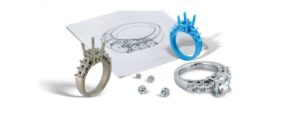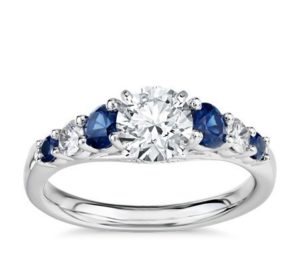Have you and your significant other been thinking about taking the next step together? Maybe you’ve started to talk about life as a married couple. As you begin to plan your future together, you’re filled with eager anticipation as you look forward to this next exciting adventure you’ll take as a couple.
For many couples, one of the first steps in this process is going ring shopping together. But this can be an intimidating process, especially if the jeweler begins using confusing terminology and referencing grading scales you’ve never heard of before. What is a carat, anyway? And who knew there were so many different cuts for a diamond?
Ring shopping should be a fun, exciting and rewarding experience for the two of you to share. Rather than have your experience spoiled by confusion about the ins and outs of engagement rings, why not do a little research before you go out? It might even be a good idea to bring a cheat sheet with you, with some of the most important information written on it.
To help you out and get you started on the right foot, we’ve put together a guide with everything you’ll need to know to begin shopping for engagement rings. We hope this will help keep the process easy and enjoyable for you and your future spouse. With this extra knowledge, you’ll be able to communicate more clearly about what you’re looking for.
The Anatomy of an Engagement Ring
Here are the basic parts of an engagement ring and the types of materials they can be made with, the setting you can choose, and the stones you may consider.
THE BAND FOR YOUR ENGAGEMENT RING
The band is the section of the ring that goes around the finger. Even though this might seem like a standard piece with not a lot of variety from ring to ring, there are actually a wide range of styles.
First, you’ll have to decide what type of metal you want the band to be made from. The most common options are:
Gold
Gold is the most typical choice for an engagement ring. It usually comes in three different shades — white, yellow and rose.
Platinum
Platinum will have almost the same appearance as white gold, but it’s stronger, more durable and will last longer.
After you’ve chosen the material your band will be constructed from, there’s also the ornamentation to consider. You might choose a standard, all-metal band with no decoration. You might decide to have the band inlaid with any number of diamonds or adorned with intricate carvings (see designers like Tacori and Kirk Kara) or milgrain detailing (with tiny metal beadwork along the edges). A fun spin on engagement rings is the split shank, in which the band splits off toward the center stone.
The Setting for Your Engagement Ring
The setting is the part of the ring that holds your center stone in place. It rests on the band and is positioned on top of the finger. It must be functional, as it holds your center stone securely, but it also can be decorative, adding a little extra beauty and ornamentation to your ring.
With that in mind, here are some of the most popular styles of settings for engagement rings:
Prong
This style of setting features a set of claw-like arms that form a basket-like shape and hold the stone firmly in place. The arrangement might be four prongs that sit at each corner, six prongs that form a star shape around the diamond or any other number of prongs and patterns.
Cathedral
This style of setting features slopes of metal that gently rise up on either side of the center stone to hold it in place. This type of setting might also be called a contour setting.
Bezel
In this setting type, a band of metal entirely surrounds the center stone and secures it in place.
Channel
This type of setting is common with engagement rings that feature a band of diamonds. It uses a band of metal running down each side of the row of diamonds. The outside metal bars protect the diamonds and hold them in place without using metal to separate the individual stones.
Bar Channel
Bar channel works exactly like the channel setting, except it employs extra bars between the individual diamonds to help hold them in place more securely.
Pavé
Tiny metal beads or prongs are used in pavé settings to give the illusion that the shank is covered in diamonds.
The Stone for Your Engagement Ring
It might seem pretty self-explanatory. But there’s actually a bit of terminology that comes along with the stone, as well. We’ll brush up on these basic terms before moving on to some more in-depth information.
Center Stone
This is the largest stone in your ring, the one that immediately draws the eye. It’s the centerpiece of the ring and what the rest of the ring is designed around. Everything else that goes into the ring, whether it’s extra stones or ornamentation of the band, is all designed to complement the center stone. There’s no requirement that this center stone must be a diamond, but this is by far the most traditional choice.
Solitaire
This style of ring features one single diamond that sits alone on the ring. This style is simple but elegant since the lack of other stones draws the attention solely to the single stone. The band may or may not be ornamented.
Three Stones
This describes a style of ring that features one center stone prominently, but also features one smaller stone on either side of the center stone. These are not simply part of the band, but are stones in their own right. This is also known as a sidestone style.
Halo
This is a term that describes a circle of smaller stones surrounding the center stone in a halo-like effect. The result is that the center stone appears larger than it actually is.
Let’s Talk About Your Center Stone: The Four Cs
There are four main categories by which diamonds and other stones are evaluated. These are known as the Four Cs, which are color, clarity, cut and carat. Jewelers evaluate each of these Cs separately, on their own different scales. Taken together, they determine the ultimate value of any diamond.
By familiarizing yourself with all four of these categories, you can become more informed on the value of the stone you choose for your engagement ring.
- COLOR
All diamonds are rated on a color grade scale. Less noticeable color means the diamond is more valuable.
Diamonds are ranked on a 23-point scale that ranges from D to Z, with D being a pure, colorless stone, and Z being a light brown or yellow color. Obviously, the difference between a D and a Z stone will be clearly visible to the casual observer. On the other hand, the difference between a D and an E stone — or even a D and an F stone — will be far more subtle. Only a trained diamond grader — including our Beryl Jewelers diamond consultants — will be able to spot the differences between these letter grades.
This color grading comes into play mostly when one considers the quality and pricing of a diamond. Diamonds that are the most chemically pure and have the most perfect structure are absolutely colorless.
Because of this, the highest-quality diamonds are those with a D grade. These also are the most costly diamonds, although the three other Cs also play into the price and value of a diamond.
DIFFERENT SHADES OF DIAMONDS
Of course, not every diamond is colorless, or a pale yellow or brown. Diamonds come in other shades such as red, blue, pink and purple. These tend to be much rarer than colorless or yellow diamonds, and are known as fancy color.
All fancy-color diamonds are rare, but some are rarer than others. For example, a brown diamond is more common than a green diamond. Fancy-color diamonds are not rated on the same structured, methodical D-Z color scale explained above. However, their value is still determined by how saturated the color is. The more saturated the color, the more valuable the diamond.
- CLARITY
This category refers to any imperfections that may be present in the diamond. As you might expect, the fewer imperfections present in a diamond, the more value the diamond has.
These imperfections have to do with how diamonds are formed. Diamonds are the natural product of carbon that has been exposed to immense heat and pressures deep within the earth. This is an intense process, and the result is that no two diamonds are the same. Some are clear, some are colored, some are big, some are small and almost all come with tiny imperfections.
These imperfections are often the result of miniscule crystals created as the diamond was formed. If these imperfections are on the inside of the diamond, they’re known as “inclusions.” If they appear on the outside of the stone, they become “blemishes.”
EVALUATING A STONE’S CLARITY
When it comes to evaluating a diamond’s clarity, a jeweler will have to consider the number of these imperfections, as well as their size, location, nature and overall effect on the appearance of the stone. Of course, no diamond is perfectly pure, but the closer a diamond comes to purity, the more valuable it will be.
Diamonds are examined by jewelers under 10x magnification and then rated for their clarity on a scale with six main categories. Although the differences between some of the adjacent categories might be impossible to see with the naked, untrained eye, they make a significant difference in the quality and price of the gem.
The categories are as follows:
- Included — The diamond has inclusions that are plainly noticeable and may affect the overall brilliance of a diamond. Also called I1, I2 or I
- Slightly Included — The diamond has detectable inclusions. Also called SI1 or SI
- Very Slightly Included — The diamond has detectable inclusions that can be observed with some effort, but these inclusions are still minor. Also called VS1 or VS
- Very, Very Slightly Included — The diamond has some detectable inclusions, but they are so minimal even a skilled grader struggles to see them. Also called VVS1 or VVS
- Internally Flawless — The diamond has no detectable inclusions. Also called IF.
- Flawless — The diamond has no detectable inclusions or blemishes. Also called FL.
- CUT
The diamond’s cut refers to two different elements of the stone. Firstly, the term “cut” references the shape of the stone itself. Some examples of popular cuts include round, princess, cushion, oval, emerald, pear, marquise, radiant, heart, Asscher and trillion.
However, in the context of the Four Cs, “cut” actually refers to a third way to evaluate diamonds based on the way they’re cut. In this situation, the cut has less to do with the physical shape and more to do with the way the diamond’s facets reflect light.
This category is the most challenging and the least standardized when it comes to assigning an actual ranking or number to a diamond. Ultimately, all diamonds are ranked on a five-point scale, ranging from an “excellent” ranking at the top of the scale to a “poor” ranking at the bottom.
- CARAT WEIGHT
You might have seen the term “carat” in writing and wondered if it’s different than the term “karat.” You’d be forgiven your confusion, since the two words have the same pronunciation. But they actually refer to entirely different things. Karat is a way to measure the purity of gold, whereas a carat is a unit of measurement to determine the weight of a diamond or other gemstone. Here’s a primer on carats:
- A carat is equal to 200 milligrams.
- The carat can then be subdivided into 100 points. This allows for exact precision when it comes to measuring the weight of diamonds.
- Some diamonds that are below one carat are only referred to by their point value. An example would be a .50 carat diamond, which a jeweler would refer to as a “50-pointer.”
The difference between single points on the scale is almost impossible for an untrained eye to see. But it can make a noticeable difference, particularly when it comes to the quality and price.
Carat weight certainly factors into the price of a diamond, since larger diamonds are more expensive than smaller ones. But the other three Cs factor in, as well. Because of this, two diamonds that have an equal carat weight might end up being vastly different prices due to differences in color, clarity and cut.
Putting It All Together: The Ideal Engagement Ring
By taking into consideration all the different pieces of an engagement ring — the band, the setting and the stone — you can be better prepared to ask for what you want. And with all the knowledge of how different diamonds are rated and graded against one another, you can be more informed about what you’re looking for. By keeping all these things in mind, we hope you’ll be able to shop with more confidence, enthusiasm and excitement.



